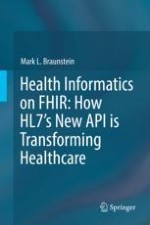
2018 | OriginalPaper | Buchkapitel
1. A Brief History and Overview of Health Informatics
verfasst von : Mark L. Braunstein
Erschienen in: Health Informatics on FHIR: How HL7's New API is Transforming Healthcare
Aktivieren Sie unsere intelligente Suche, um passende Fachinhalte oder Patente zu finden.
Wählen Sie Textabschnitte aus um mit Künstlicher Intelligenz passenden Patente zu finden. powered by
Markieren Sie Textabschnitte, um KI-gestützt weitere passende Inhalte zu finden. powered by